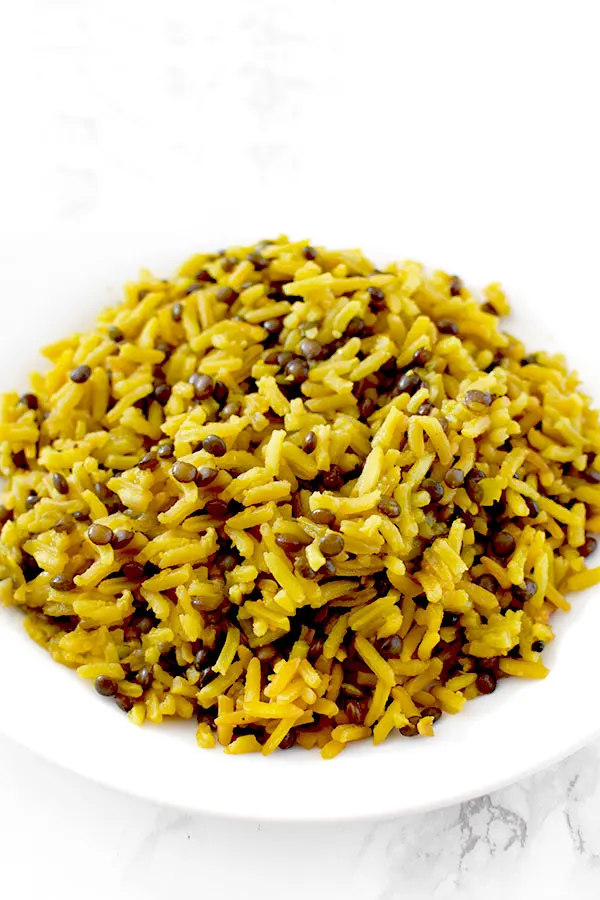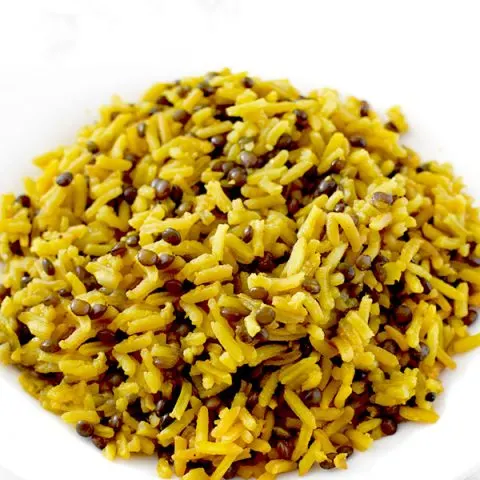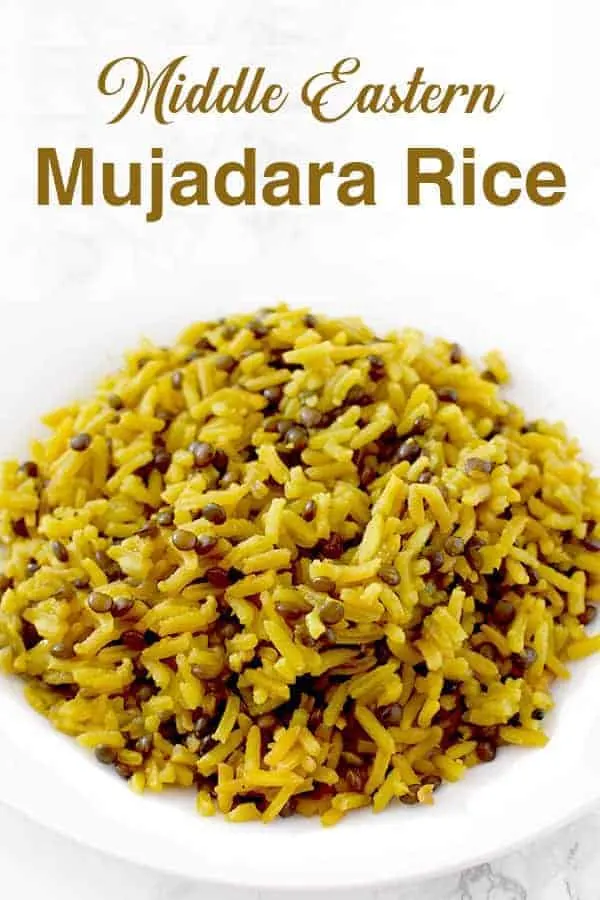Mujadara is a popular side dish in Israel and throughout the Middle East made of rice and lentils topped with fried onions. Serve alongside chicken or meat.

Mujadara is believed to have originated in modern day Iraq during the Middle Ages.
It is also is said to have been inspired by lentil dish Jacob used to buy Esau's birthright.
The original recipe contained rice, lentils, and meat and was served this way during celebrations. However, a vegetarian version was commonly eaten by the poor.
Today, the vegetarian version is much more commonly found in Israel and throughout the Arab world.
In Israel it is served in restaurants and hot lunches alike.
Mujadara can be made white or yellow.
In Israeli restaurants in New York I’ve only seen the white version served on the side of Chicken Shawarma.
In Israel, on the other hand, the yellow version is much more common and I’ve usually seen it as a side to some sort of meat.
Can I leave out the onions?
Yes. Though every recipe I’ve seen includes them, I’ve often seen it served without them.
I actually prefer it without them because I find their flavor a little too dominating for a side dish.
WHY SORT RICE
Sorting rice is useful because I’ve actually found bugs in rice before, especially with already opened bags of rice.
To be sure the rice is clean, measure out how much rice you need, then pour some of it out onto a white plate.
Sift through the rice to make sure there are no bugs – some of which look like small worms.
When done, pour the sorted rice into a pot and repeat with the remaining rice.
As a secondary step, I then fill the pot with water and agitate the rice with my fingers. This helps get anything that may have been missed to float to the top.
Pour out the water, and if you found anything, repeat until nothing comes up.
HOW TO STORE DRY RICE
Store the remaining dry rice by placing it in an airtight container or a resealable plastic bag. Keep it in a cool, dark place.
Doing so will protect the rice from bugs.
I always check the rice before using it even when it is stored well, just in case.
WHY WASH RICE
There are three benefits to rinsing rice.
Firstly, it removes any debris.
Secondly, it removes surface starch. If the starch is not removed, it can cause the rice to clump together and get gummy as it cooks.
Thirdly, if there are any bugs in the rice that weren't caught, they will float to the surface while being washed.
Some say to rinse the rice repeatedly until the water runs clear. This isn’t necessary.
Instead, rinse the rice thoroughly a few times. After that, most of the starch should be removed and the water should be only slightly cloudy.
The way I like to wash rice is by putting it in a large bowl or a pot and filling it with water. Then, I shape my hand into a claw and use it to agitate the rice.
This brings up both debris and bugs that may have been missed during sorting.
WHY TOAST RICE
Toasting rice is a step some recipes require where you first lightly fry the uncooked rice. This step is usually done with rice that has not been rinsed.
As with toasting spices and nuts, toasting grains before cooking can enhance their flavor.
Rice is no exception, as it gains a nutty depth which adds an extra layer of flavor to a final dish.
Another benefit is that by toasting the rice first, you are cooking the starches.
This, like washing rice, helps prevent the rice from being sticky. Instead, each grain cooks separately.
RATIO WATER TO RICE
There are many different types of rice. The most popular types require two cups of water for one cup of rice. Some, however, need less water:
Short Grained Rice needs 1 and ⅛ cups water.
Basmati Rice needs 1 and ¼ cups water.
American Long Grain Rice needs 1 and ½ cups water.
Jasmine Rice needs 1 and ¾ cups water.
Also, when multiplying the recipe, rice often needs less water than you’d think. For example, with American long grain rice:
1 cup rice needs 1 and ½ cups water.
2 cups rice need 2 and ¾ cups water.
3 cups rice need 3 and ½ cups water.
HOW TO STORE RICE
Transfer the cooled, cooked rice into an airtight storage container or a resealable plastic bag. Make sure to remove as much air from the bag as possible before sealing it.
Store in the refrigerator for 3 to 5 days.
HOW TO FREEZE RICE
Transfer the cooled, cooked rice into a resealable freezer bag, making sure to remove as much air from the bag as possible before sealing.
Store for up to 6 months. After that, it is still safe to eat, but the quality begins to degrade.
REHEATING RICE
FROM THE FRIDGE
When reheating, place the rice in a pot, sprinkle a teaspoon of water over the top to help loosen stuck, dried grains, then place.
Heat over medium heat, stirring constantly to keep the grains moving, but be careful not to mash them.
FROM FREEZER
Frozen grains can be added directly to hot dishes like stir-fries. If you’re planning on eating it on its own, follow the steps above.
SNAFU
The first time I made mujadara I tried using orange lentils because I thought they'd look nice against the white rice. However, the cooked into a yellow that did not look very good.
On my second attempt, I used black lentils which were recommended to me. This came out worse than the yellow lentils because it turned the rice a blackish gray.
On my third try, I used the black lentils again but added the turmeric which I had chosen to leave out the first time. This turned the dish an ugly green!
Mujadara

Mujadara is a popular dish throughout the Middle East. Serve alongside chicken or meat.
Ingredients
- 1 ½ tablespoons oil
- 3 large onions
- 1 cup basmati or Persian rice (210)
- ½ cup green or brown lentils (105 grams)
- 2 cups water (480 milliliters)
- ½ teaspoon turmeric, optional
Instructions
- Place lentils, rice, and turmeric if desired to a pot and add water.
- Let simmer for 20 minutes or until ready. Add more water as needed.
- While cooking the rice, fry onions until they are soft and brown.
- When the rice is ready, spoon it out onto a plate and top with onions.
Nutrition Information:
Yield:
8Serving Size:
1Amount Per Serving: Calories: 129Total Fat: 5gSaturated Fat: 0gTrans Fat: 0gUnsaturated Fat: 5gCholesterol: 0mgSodium: 5mgCarbohydrates: 18gFiber: 2gSugar: 3gProtein: 3g

Yehudit
Monday 19th of June 2023
Thanks for the advice about rinsing, which I never did before. And also the different amounts of water for the different types of rice. My granddaughter & I made this together & it was delicious!
ElissaBeth
Friday 4th of August 2023
I'm so glad to hear you found the information helpful and that you and you're granddaughter enjoyed the recipe :) thank you for sharing!
Leah
Wednesday 3rd of February 2021
Do you not add any salt to this recipe? Thank you.
ElissaBeth
Wednesday 3rd of February 2021
You can, but when it comes to rice I like to leave it out and let people add their own when it is served.